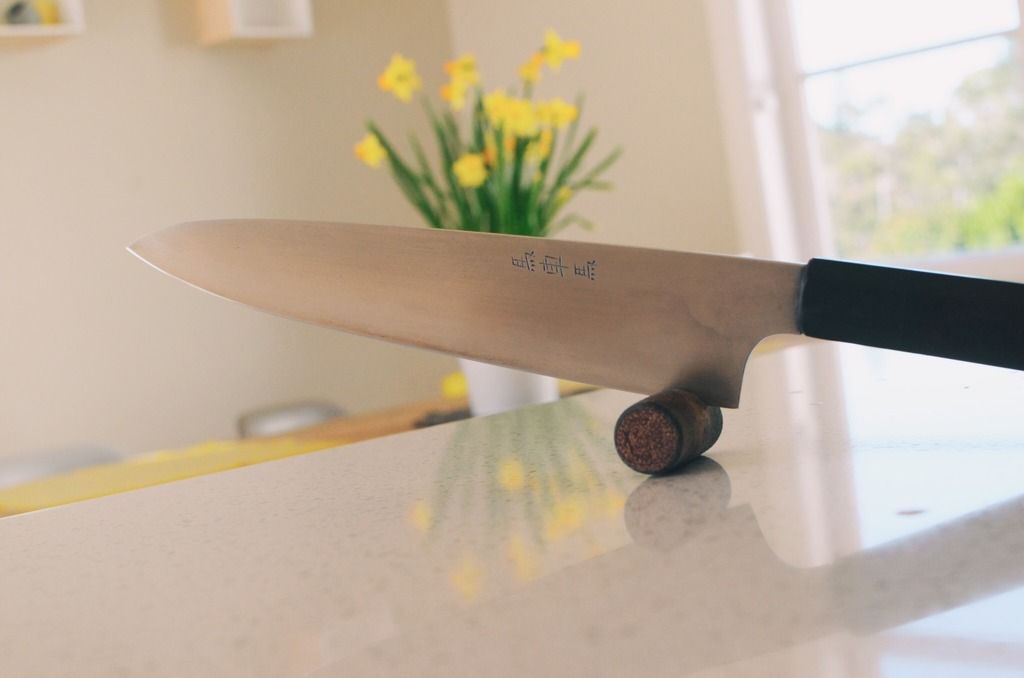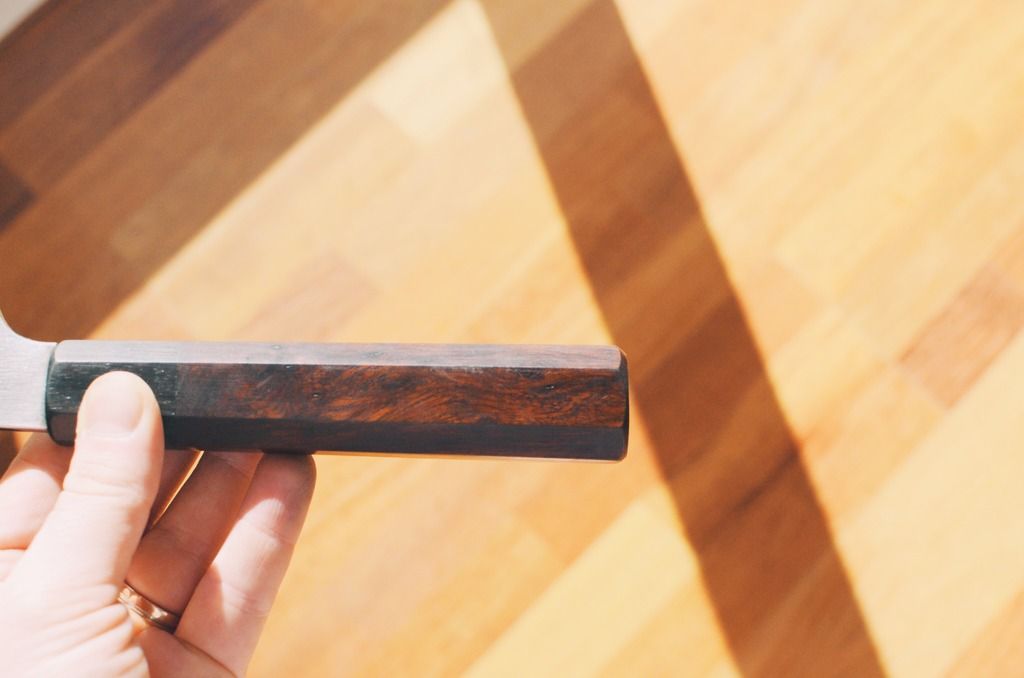If there is one J-knife that is currently a hype, it must the Kiyoshi Kato (Yoshiaki Fujiwara) workhorse knife. Perhaps together with the Shigefusa knife. I am subscribed to a mailing list by Japanese Natural Stones, who sell these knives. I get their mails about the availability of these knives on my phone, so I am usually able to respond within minutes. But every time the knives were sold out by then already...
Fortunately I was able to obtain a 240 mm Kato workhorse knife second-hand (but not used a lot). It had been rehandled by Greg Gola of Wabocho, who replaced the standard burnt chestwood handle by a nice handle made of ironwood. So now I was of course very curious how it cuts.
To have a reference, I decided to compare it to some other workhorse knives. See another post for a comparison between these knives: a Heiji, a Watanabee and a Kochi.
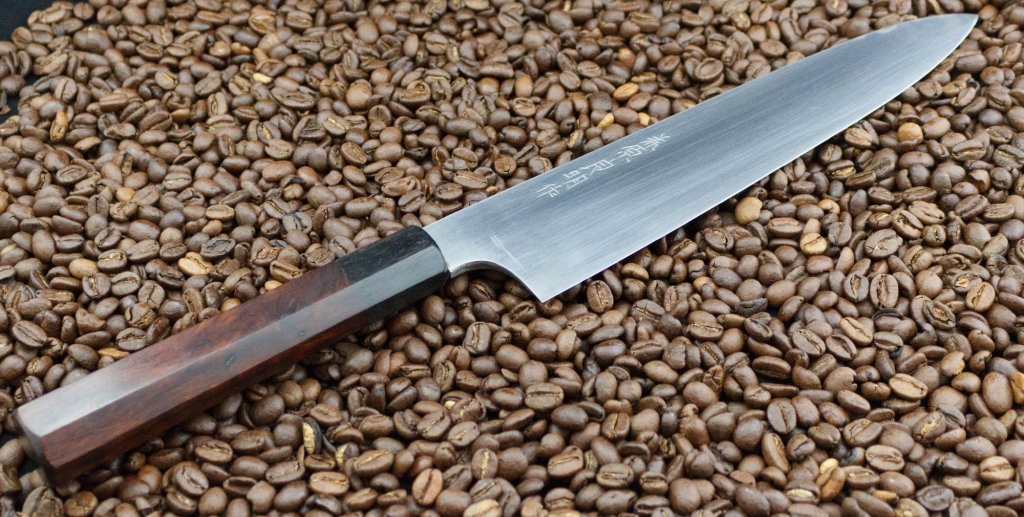
Fit and finish
The Kato is well finished. The spine and choil have been rounded, although there were still some minor sharp areas on the choil. The knife came well polished and had the makers mark engraved at both sides.
Id describe the Kato profile as pretty all-round. It has a proper flat spot, but also a nice upward curve towards the tip.

The knife is quite thick. At the heel it is 5 mm wide at the spine and halfway the blade it is still 2.8 mm wide. This tapers down to 1 mm at 1 cm from the tip. At 250 grams it is the heaviest knife in my collection.

The knife has a convex grind. However, unlike on most knives with such a grind, the convexity changes over the length of the blade. (When you look at the choil shot in the factsheet, it may even seem somewhat concave right at the choil.) In the picture below the red line indicates where approximately the main convexity curve is. The blade does not have a shinogi line, but if it were to have one, this would about be where it is. Thanks to Asteger of Kitchen Knife Forums for pointing this out.

Cutting performance
I usually start my cutting tests with onions. Although the Kato doesnt have the thinnest tip, it dealt well with them. Much better, for example, than my Heiji gyuto, which is 1.3 mm tick at 1 cm from the tip.
The Kato also dealt well with most other veggies I threw at it. It was particularly a joy to use it with sticky products like potatoes: food release was excellent and better than on any of the other workhorse knives. Unfortunately the knife doesnt fall through food, as the saying goes, but it sometimes does give that impression.
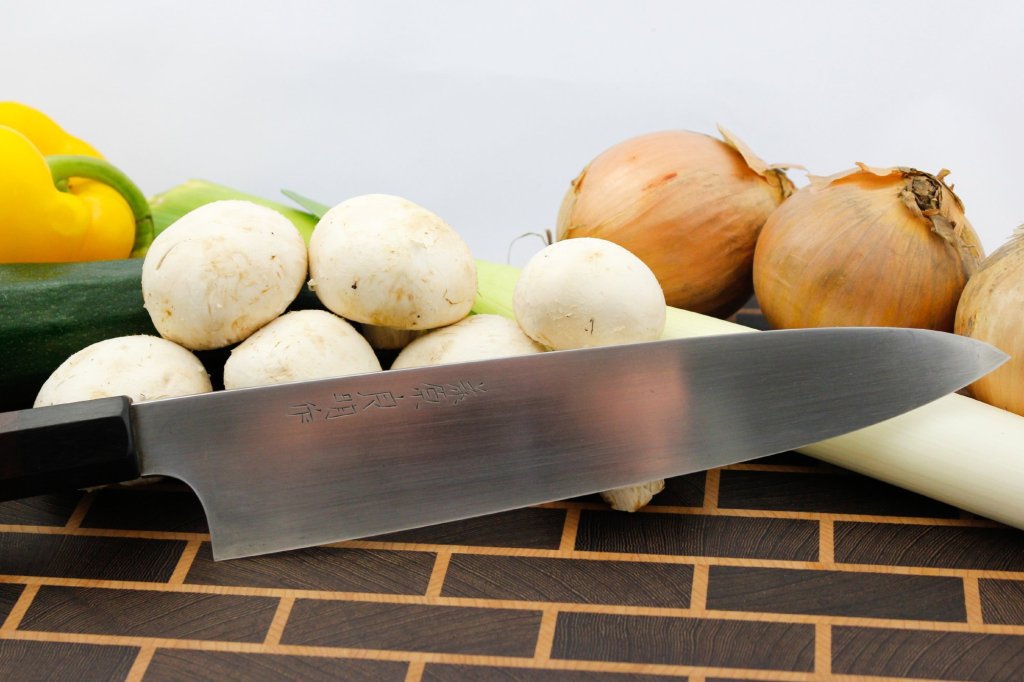
Only on hard and dense materials, like carrots, white winter radish and sweet potatoes, it required a little more force to cut these products than with my favourite workhorse knife, the Watanabee. This is perhaps not surprising, given the width of the blade: one simply needs more lateral force to separate the food.
This is not wedging, a term that is widely misused. Wedging means that an object (in this case a knife) gets stuck in another object. Here a convex blade helps, because a smaller part of the blade is in contact with the material being cut than a with a V-edge. See a separate blog post I wrote on this for more information. And the convexity on the Kato knife is very good.
(Similarly, stiction, another widely misused term, is not the same as stickiness. Stiction is the static friction that needs to be overcome to enable relative motion of a stationary object in contact. So if a knife has wedged, it will require some threshold force to get it moving again.)
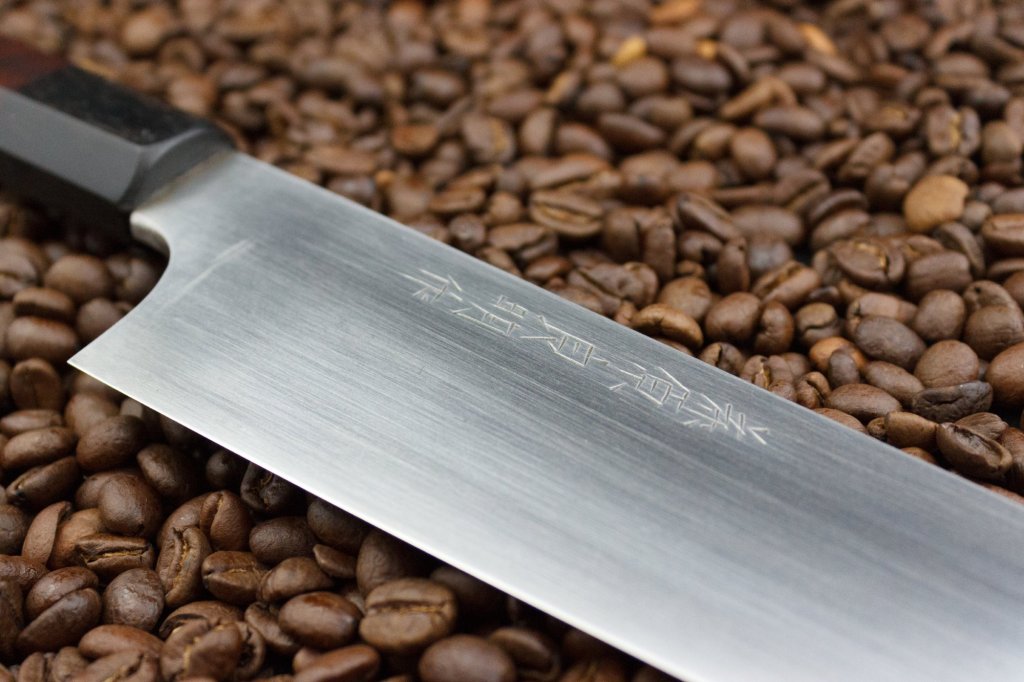
One thing I did notice when using this knife is that it is heavy! My favourite workhorse knife, the Kochi, weighs 167 grams and this Kato weighs almost 100 grams more. This is not an entirely fair comparison, since the Kochi is 3 cm shorter, but I did feel some fatigue in my wrist after a long cutting session with the Kato.
So my initial impression was that this knife is a very good cutter with great food release, but too heavy for me. There is a reason that I switched from German knives to Japanese knives, and that is not only the steel. But to my surprise I found myself grabbing my Kato again and again every time I had to cut a larger amount of not too dense ingredients. It is not great on pumpkins or white winter radish, but it excels in cutting larger amounts of cabbage, tomatoes or potatoes. For some reason I like the heft of the knife and the fact that it is quite blade-heavy. And I love the profile.
So I started using it more often and the knife grew on me. I also got to like the steel a lot. It sharpens up very easily (you have a burr in no time) and you can get it nearly as sharp as white steel. Edge retention seems to be on par with blue steel. So it's a bit like Aogami Super steel. The steel easily forms a stable patina, but doesn't smell, also not initially. And I've never seen a rust spot on this knife.
Conclusion
A Kato is the epitome of a workhorse knife: heavy, sturdy and with great food release. And great steel. Compared to other (thinner) workhorse knives it does require some additional force to cut through hard and dense products. But in spite of its thickness, it hardly wedges.
Is it a unique knife that cuts excellently? Definitely. Does it live up to the hype? I guess thats up to you and whether you like a thick and heavy knife. And the price. But do give it some time: initially I thought it was too heavy for me, but now it is a knife I thoroughly enjoy.
Factsheet
The numbers in the factsheets refer to the knife with the original handle.
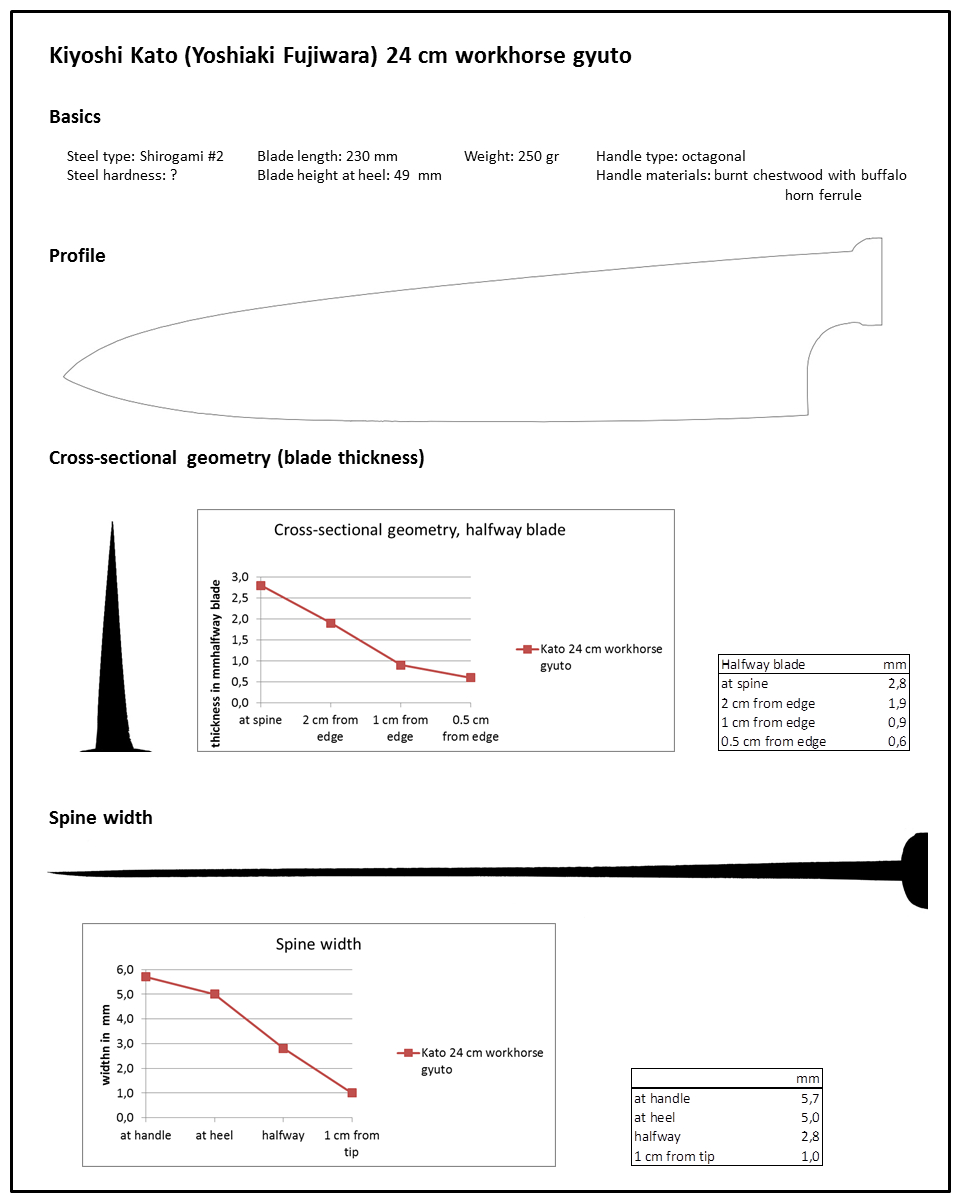
Fortunately I was able to obtain a 240 mm Kato workhorse knife second-hand (but not used a lot). It had been rehandled by Greg Gola of Wabocho, who replaced the standard burnt chestwood handle by a nice handle made of ironwood. So now I was of course very curious how it cuts.
To have a reference, I decided to compare it to some other workhorse knives. See another post for a comparison between these knives: a Heiji, a Watanabee and a Kochi.

Fit and finish
The Kato is well finished. The spine and choil have been rounded, although there were still some minor sharp areas on the choil. The knife came well polished and had the makers mark engraved at both sides.
Id describe the Kato profile as pretty all-round. It has a proper flat spot, but also a nice upward curve towards the tip.

The knife is quite thick. At the heel it is 5 mm wide at the spine and halfway the blade it is still 2.8 mm wide. This tapers down to 1 mm at 1 cm from the tip. At 250 grams it is the heaviest knife in my collection.

The knife has a convex grind. However, unlike on most knives with such a grind, the convexity changes over the length of the blade. (When you look at the choil shot in the factsheet, it may even seem somewhat concave right at the choil.) In the picture below the red line indicates where approximately the main convexity curve is. The blade does not have a shinogi line, but if it were to have one, this would about be where it is. Thanks to Asteger of Kitchen Knife Forums for pointing this out.

Cutting performance
I usually start my cutting tests with onions. Although the Kato doesnt have the thinnest tip, it dealt well with them. Much better, for example, than my Heiji gyuto, which is 1.3 mm tick at 1 cm from the tip.
The Kato also dealt well with most other veggies I threw at it. It was particularly a joy to use it with sticky products like potatoes: food release was excellent and better than on any of the other workhorse knives. Unfortunately the knife doesnt fall through food, as the saying goes, but it sometimes does give that impression.

Only on hard and dense materials, like carrots, white winter radish and sweet potatoes, it required a little more force to cut these products than with my favourite workhorse knife, the Watanabee. This is perhaps not surprising, given the width of the blade: one simply needs more lateral force to separate the food.
This is not wedging, a term that is widely misused. Wedging means that an object (in this case a knife) gets stuck in another object. Here a convex blade helps, because a smaller part of the blade is in contact with the material being cut than a with a V-edge. See a separate blog post I wrote on this for more information. And the convexity on the Kato knife is very good.
(Similarly, stiction, another widely misused term, is not the same as stickiness. Stiction is the static friction that needs to be overcome to enable relative motion of a stationary object in contact. So if a knife has wedged, it will require some threshold force to get it moving again.)

One thing I did notice when using this knife is that it is heavy! My favourite workhorse knife, the Kochi, weighs 167 grams and this Kato weighs almost 100 grams more. This is not an entirely fair comparison, since the Kochi is 3 cm shorter, but I did feel some fatigue in my wrist after a long cutting session with the Kato.
So my initial impression was that this knife is a very good cutter with great food release, but too heavy for me. There is a reason that I switched from German knives to Japanese knives, and that is not only the steel. But to my surprise I found myself grabbing my Kato again and again every time I had to cut a larger amount of not too dense ingredients. It is not great on pumpkins or white winter radish, but it excels in cutting larger amounts of cabbage, tomatoes or potatoes. For some reason I like the heft of the knife and the fact that it is quite blade-heavy. And I love the profile.
So I started using it more often and the knife grew on me. I also got to like the steel a lot. It sharpens up very easily (you have a burr in no time) and you can get it nearly as sharp as white steel. Edge retention seems to be on par with blue steel. So it's a bit like Aogami Super steel. The steel easily forms a stable patina, but doesn't smell, also not initially. And I've never seen a rust spot on this knife.
Conclusion
A Kato is the epitome of a workhorse knife: heavy, sturdy and with great food release. And great steel. Compared to other (thinner) workhorse knives it does require some additional force to cut through hard and dense products. But in spite of its thickness, it hardly wedges.
Is it a unique knife that cuts excellently? Definitely. Does it live up to the hype? I guess thats up to you and whether you like a thick and heavy knife. And the price. But do give it some time: initially I thought it was too heavy for me, but now it is a knife I thoroughly enjoy.
Factsheet
The numbers in the factsheets refer to the knife with the original handle.






